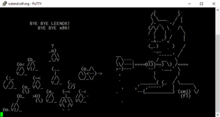SDF Public Access Unix System

Super Dimension Fortress (SDF, also known as freeshell.org) is a nonprofit public access UNIX shell provider on the Internet.
It has been in continual operation since 1987 as a non-profit social club. The name derives from the Japanese anime series The Super Dimension Fortress Macross (the original server was originally a BBS for anime fans[1]).
Services
The system currently includes NetBSD servers for regular use (running on DEC Alpha- and AMD Opteron-powered hardware) as well as a TWENEX, and a Symbolics Genera system. Besides offering free Unix shell access to its users, SDF provides dialup access and web and Gopher hosting. It's one of very few servers still running the latter protocol.
The system contains thousands of programs and utilities, including a BBS, chat program, email programs, webmail, and developer tools. SDF allows schools the use of SDF's computing resources for Unix classes.[2]
History
In 1987, Ted Uhlemann started SDF on an Apple IIe microcomputer running "Magic City Micro-BBS" under ProDOS. The system was run as a "Japanese Anime SIG" known as the SDF-1. In 1989, Uhlemann and Stephen Jones operated SDF very briefly as a DragCit Citadel BBS before attempting to use an Intel x86 UNIX clone called Coherent.
Unhappy with the restrictive menu driven structure of existing BBS systems, Uhlemann, Jones and Daniel Finster created a UNIX System V BBS in 1990, initially running on an i386 system, which later became an AT&T 3B2/400 and 500, and joined the lonestar.org UUCP network. Three additional phone lines were installed in late 1991.
In the fall of 1992, Uhlemann and Finster left SDF to start one of the first commercial Internet companies in Texas, Texas Metronet.
SDF continued to grow, expanding to ten lines in 1993 along with a SLIP connection provided by cirr.com. UUCP was still heavily relied upon for Usenet news and email.
In 1997, SDF (then with about 15,000 users) migrated to Linux. The migration to Linux marked a turning point, as the system started coming under attack like it never had before in its history. Jones calls the Linux period the dark age.

In part due to the number of attacks undertaken by malicious users against SDF, the years 2000 and 2001 saw SDF migrate from Linux to NetBSD and from Intel x86 to DEC Alpha. This migration included relocation of the servers from Lewisville, Texas to Seattle, Washington. The Linux system was officially decommissioned on August 17, 2001. The occasion was captured in a COMMODE Log preserved by one of SDF's users.[3] (COMMODE is a DEC TOPS-20 chat system ported by Jones to Unix as an executable Korn_shell script.)
Although SDF Public Access UNIX System was registered as an operating business in 1993 according to the Dallas County Records Office, it wasn't until October 1, 2001, that the SDF Public Access UNIX System was formed as a Delaware not-for-profit corporation and subsequently granted 501(c)(7) non-profit membership club status by the IRS. SDF had operated under the auspice of the MALR corporation between 1995 and 2001.
Current status
SDF is now composed of 47,572 users from around the world as of April 28th, 2016. SDF users include engineers, computer programmers, students, artists and professionals.
References
- ↑ "PUBNIX-System SDF-1 feiert 20-jähriges Jubiläum | heise Netze". Heise.de. Retrieved 2014-05-09.
- ↑ "SDF Public Access UNIX System - Free Shell Account and Shell Access". Sdf.org. Retrieved 2014-05-09.
- ↑ "pooderNet: bye-bye-leenox". Bch.sdf.org. Retrieved 2014-05-09.
Further reading
- Sterling, Bruce (1992). The Hacker Crackdown : Law and Disorder on the Electronic Frontier. New York: Bantam Books.
External links
- Official website
- @sdf_pubnix on twitter
- Interview with Stephen Jones at bsdtalk (MP3)
- Vintage Computer Festival SDF Exhibit
- 2012 Feature Story on NPR, "In Noisy Digital Era, 'Elegant' Internet Still Thrives"